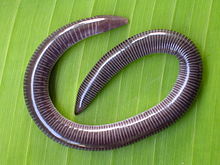Uraeotyphlus
| Indian caecilians | |
|---|---|
 |
|
| Uraeotyphlus narayani | |
| Scientific classification | |
| Kingdom: | Animalia |
| Phylum: | Chordata |
| Subphylum: | Vertebrata |
| Class: | Amphibia |
| Order: | Gymnophiona |
| Family: |
Uraeotyphlidae , 1979 |
| Genus: |
Uraeotyphlus W. Peters, 1879 |
| Species | |
|
Uraeotyphlus gansi |
|
Uraeotyphlus gansi
Uraeotyphlus interruptus
Uraeotyphlus malabaricus
Uraeotyphlus menoni
Uraeotyphlus narayani
Uraeotyphlus oommeni
Uraeotyphlus oxyurus
Uraeotyphlus gansi
Uraeotyphlidae is the family of Indian caecilians. It is a monotypic family containing a single genus, Uraeotyphlus. Alternatively, Uraeotyphlus is placed in the family Ichthyophiidae. There are seven species of caecilians in this genus, all of which are found in the Western Ghats in Kerala State, peninsular India.
They are relatively small sized caecilians ranging from 23 centimetres (9.1 in) to 30 centimetres (12 in) in length. Unlike the more 'advanced' caecilians, members of this family have a true tail with vertebrae, and their skull has a relatively complex structure. However, unlike the more 'primitive' caecilians, the mouth is recessed below the snout, there are no tertiary annuli, and the tentacular opening are far forward of the eyes, and below the nostril. Molecular studies support their placement as a sister taxon to Ichthyophiidae.
They are burrowing animals, which lay eggs that hatch into free-living larvae. Their habitat is primarily the soil of the tropical forest floor.
Family Uraeotyphlidae
...
Wikipedia
